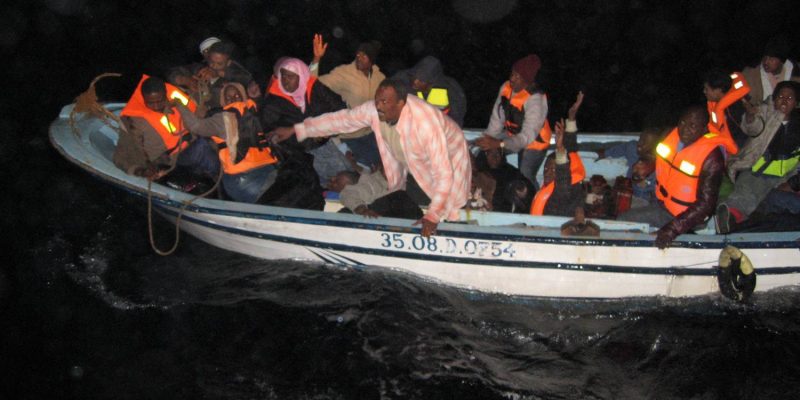1. The Mediterranean crisis between the failed EU policies and the attacks on NGOs
“The evolution of people-smuggling in the central Mediterranean is a story of unintended consequences,” writes Daniel Howden in the Guardian. Read his compelling analysis of the situation out at sea, amid EU missions that fail to meet their goals (while making things worse) and the attacks on humanitarian NGOs trying to fill the gap left by the governments.
2. EU refugee anti-smuggling mission is driving deaths in the Mediterranean
While politicians and the media everywhere in Europe are busy discussing the NGOs, a Parliamentary inquiry documents the failure of the latest EU naval mission in the Mediterranean. The UK House of Lords has published a report on Operation Sophia that shows how the anti-smuggling strategy has only led to more deaths at sea: while Europe is busy destroying smugglers’ ships, huge numbers of migrants are now using less safe rubber dinghies, making the crossing all the more dangerous. Read the articles by Alan Travis in the Guardian and by May Bulman in the Independent.
3. Italy’s smuggling prosecutions ruin lives
Thousands of pilots and navigators of migrant boats have been jailed in Italy as “scafisti”, as part of the government’s strategy. But those who are prosecuted are often escaping migrants who found themselves at the helm by chance or by force, while the real criminals go free. Read this important article by Ilaria Sesana for Refugees Deeply.
4. Italia, safe and legal passage for (some) asylum seekers via humanitarian corridors
An alternative to the desperate crossing of the Mediterranean exists, even though only for a lucky few. Civil society groups have stepped in to fill the gap left by the government with the pilot project of humanitarian corridors, which has allowed safe and legal passage to almost 1,000 Syrian asylum seekers so far. Read the article by Michele Bertelli for Politico.
5. Italy, those who are really helping refugees “at home”
Three stories of Italian families who decided to take in a refugee, with great rewards and lots of hard work, and of the association (Refugees Welcome Italia) that helped them open up their hearts and their homes. Read the article by Luca Misculin in Il Post.
6. The limbo at the Libyan border
Letters from Tunisia, describing the desert limbo at the former refugee camp of Choucha, officially closed years ago, and finally evacuated only a few weeks ago. Read Thessa Lageman’s article in Al Jazeera (as well as our own report).
7. The consequences of the EU-Turkey deal on the mental health of refugees
A new report from Human Rights Watch documents the impossibly high cost of the EU-Turkey deal that resulted in the closing of the Aegean route. Among the thousands of refugees trapped in Greek camps in desperate conditions, there is an alarming rate of self-harm and suicide. Read Lizzie Dearden’s article in the Independent, as well as the one in Vice on what is left of the migrants who died trying to cross from Greece into Turkey).
8. The Rohingya refugees that nobody wants
There are almost 300,000 Rohingya refugees living in Bangladesh in extremely precarious conditions, between makeshift camps and informal settlements. Nathan A. Thompson’s report for CNN takes us to meet the refugees that nobody wants.
9. Seeking asylum from the US to Canada, at what cost?
Meanwhile, in the USA, doors are being closed on refugees, and more and more are trying to cross into Canada. Razak Iyal and Seidu Mohammed have become a symbol of despair among asylum seekers in Trump’s America, after they lost fingers to frostbite while crossing the Canadian border in deep snow. Read Catherine Porter’s article in the New York Times.
10. Art for refugees
Integration through art and culture. For some time now, the “Multaka” (Arabic for “meeting point”) project in Berlin has placed refugees and immigrants from the Middle East at the helm of guided tours to help the integration process (an idea that was also exported to Italy). Meanwhile, in Amsterdam, refugees speak about their past (and come to terms with it) in a pop-up museum located inside a very special welcome centre: a former prison. Read the article by Austin Davis for Refugees Deeply on migrant tour guides and the one by Nina Siegal in the New York Times on the Temporary Museum.
BONUS. Data journalism to change the narrative on immigration
An experiment in data journalism to change the debate on migrants and refugees through information, keeping in mind that data is essential). This is the mission of Open Migration in theory and practice, as told by our own editor Marina Petrillo on Rai News 24 during an interview that touched on some of the most controversial topics, from Libya to the attacks on humanitarian NGOs out at sea.
Header photo: UNHCR Photo Unit (CC BY-NC-ND 2.0).









